History of the rose : from the Wild Roses towards a perfect rose

Text © Giuseppe Mazza

English translation by Peter Thompson
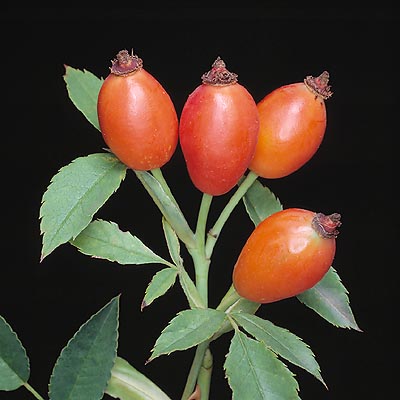
Hips of Rosa canina © Giuseppe Mazza
Hips of Rosa canina © Giuseppe MazzaWe know from fossils that, during the Oligocene, 35-40 million years ago, there was a rose growing in Oregon which was very similar to the Rosa nutkana . It belonged to the Cinnamonmeae group like the Rosa rugosa, which today one can see in yours gardens still opening its splendid flowers to the sun with five mauve petals.
We also know that the genus Rosa grows in the wild only in the northern hemisphere, where it has accompanied man since prehistoric times.
Botanically speaking, rosebushes are close relatives to apple, pear, peach, apricot, loquat, plum, almond and cherry trees, as well as strawberry plants; in short, the fruit plants.
And their remarkable red berries, in reality false fruits called hips containing akenes, were certainly appreciated by prehistoric man, due to their edible pulp which is slightly laxative and rich in vitamin C.
We can therefore imagine that some distant ancestor of ours has tried to cultivate, close to his home, a Rosa canina or a Rosa gallica.
Used to surviving in poor and arid soils, amongst brambles, when the rosebushes are well nourished they sometimes change their look.
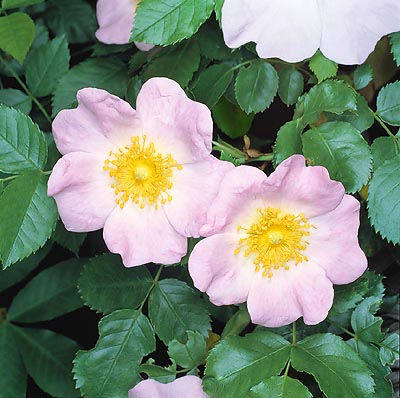
Rosa canina © Giuseppe Mazza
If we take a wild five-petal Rosa gallica and put it in a fertile and irrigated soil, without competitors around, the corolla often duplicates itself spontaneously and forms 10-15 petals. This phenomenon, it seems, is linked to the rapidity of the growth, which may induce, amongst other factors, a mutation.
Similarly, at the age of Herodotus in the fifth century BC, a Rosa canina from the fields, which normally has five petals, suddenly gave origin to a semi-plena form with ten petals.
These happenings did not go unnoticed and, in parallel with what happened in China, the rose became the first domestic, ornamental plant.
The flower became a symbol for beauty, scent and wealth; so much so that a city was called Rhodes, from Rodon, the Greek name of the rose, and many drawings of roses have been discovered on shields, coins and frescoes of the Greco-Roman world.
Greeks and Romans certainly cultivated the Rosa gallica, the red rose par excellence, which had also a medicinal variety, and the very fragrant Damask Roses, born from a crossing with the Rosa phoenicia .
Virgil tells us about an Autumn Damask, which bloomed twice a year, born from the marriage of a Rosa gallica with the Rosa moschata , also a species of Asia Minor; it had arrived from the Himalayas many centuries before.
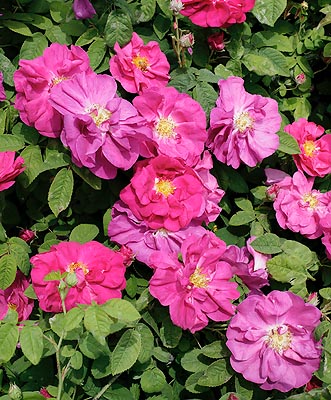
Rosa gallica officinalis © Giuseppe Mazza
Pliny the Elder, in his Naturalis Historia, tells of very fragrant roses, each with a hundred petals, which decorated the outer side of wreaths.
Already by then the rose had come a long way, but the colours of the petals in those days were limited to white, pink and red, and it wasn’t until the end of the Middle Ages, with the introduction of the Rosa foetida, that we saw the first yellow-coloured rose.
This was a fundamental step in the history of the rose, because from this species, native to Persia and south western Asia, all of the yellow and orange nuances of the modern varieties were derived, thanks to the cross-breeding with one of the first Hybrid Teas.
In the Middle Ages there were also the Alba roses, possessing characteristics of the Rosa canina , the Damask Rose and the Rosa gallica. This variety had an insuperable scent and grey-green foliage in perfect harmony with the pastel tones of the petals, which vary from pale pink to pure white.
From the second half of the eighteenth century, the world of horticulture was in full bloom. The Rosa x centifolia came into fashion, a pompous variety of one hundred perfumed petals, created in Holland and known also as “Painters’ Rose”. We often find it represented in paintings and frescoes of the time, as well as on pottery and fabrics.
It differs from the one described by Pliny the Elder, but it too is derived from old stocks, probably from a Damask Rose, the Rosa gallica officinalis and the Rosa canina.
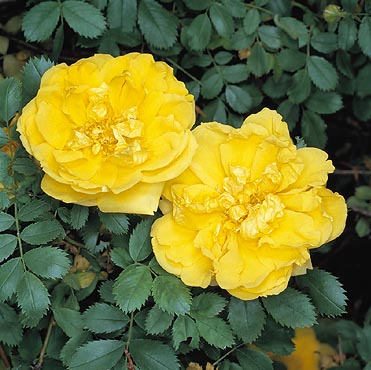
Rosa foetida persiana © Giuseppe Mazza
By the end of the century the first China roses arrived in Europe, with shipments of tea from the East India Company; they were immediately christened Tea-scented Roses, or more simply Tea , because of the scent of the cases in which they were travelling.
To avoid any misunderstanding, it should be made clear that the petals of these flowers do not smell of the aroma given out by an open box of tea; they do, nonetheless, have a typical fragrance with a dry and pungent basis, never sweet. Comparable, if one must, to the smell of the fresh leaves of tea when broken with the fingers.
They show unusual buds, long and sharp, and come from the old breeding of the Rosa chinensis and the Rosa gigantea, a climbing species of the Himalayas which reaches up to 30 metres in height thanks to its strong, hooked thorns. Above all, these exotic roses were always in perpetual blossom.
From their marriage with the European varieties, the roses of our gardens would inherit the capacity to bloom more than once, which until now was a trait reserved only for the Autumn Damask ; we thus talk about Hybrid Perpetuals, capable of producing flowers throughout the vegetative season.
Successful breeding between the Teas and the Hybrid Perpetuals finally resulted in the Hybrid Tea roses, which are nowadays seen as great queens of the flower world.
The end of the eighteenth century also saw the arrival of the Rosa rugosa from Japan, which, save for some chance crossings, established itself in a rather independent fashion, with numerous varieties which magnified the natural beauty of the single flowers, not to mention the veined leaves, rough but slightly glossy, and the large fruits.
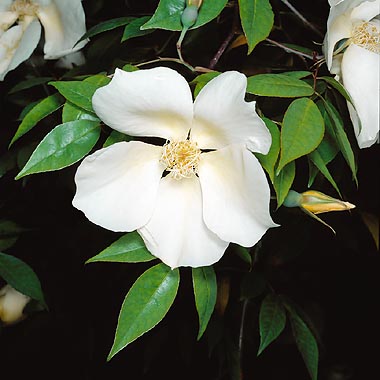
Rosa gigantea © Giuseppe Mazza
They are related to the Bourbon Rose, originating from the island of Bourbon, now known as Réunion, from the breeding of a Rosa chinensis with an Autumn Damask; of the Portland, born from a scarlet rose, probably a hybrid of Rosa chinensis , Damask and Gallica, discovered in Italy and brought to London by the Duchess of Portland; and of the Noisette, a variety with exceptional repeat flowering, created by the two Noisette brothers, one a nurseryman in Paris, the other in South Carolina, who crossed a Rosa chinensis with the Rosa moschata .
From another small group of roses with flowers united in corymbs, the Dwarf Polyanthas, born from the union of the Rosa multiflora var. nana with miniature China roses, Poulsen was able to obtain roses with bigger flowers, crossing them with Hybrid Teas, assembled in small clusters called Hybrid Polyanthas, or, simply Poulsen roses.
And from repeated crossings of these with Hybrid Teas, the Floribunda roses finally evolved, which today play an important role in our garden landscapes.
But, how does hybridisation work? How did we give birth to the 45.000 varieties of roses in existence today?
Sometimes, it’s simple. When nature gives us a helping hand in cultivation, a genetic mutation can occur spontaneously: a shrubby species can suddenly become a climbing species, or the petals, unexpectedly, can change in colour.
It is the case, for instance, of the Excelsa rose, which at the Roseraie Princesse Grace de Monaco has begun to fabricate a branch with candid snowy-white corollas, close to its regular crimson-red flowers. This is enough for us to isolate it, to reproduce it using the vegetative method, and if the variety has not yet been registered, to give it a name.
On average, 10 years are needed to create a new rose; a long period of teamwork, both artistic and scientific.
With a good dose of perception, and lot of experience, the rose breeder meticulously chooses the parents in accordance with his desired aim. He has to keep in mind the parameters which are often incompatible, such as the colour, perfume, repeat-flowering capability, look and resistance to diseases.
Then he does what a bee would have done in the wild: to take the pollen from the plant chosen as father, and place it on the feminine organ of the plant selected to be the mother.
The method of hybridization is always the same.
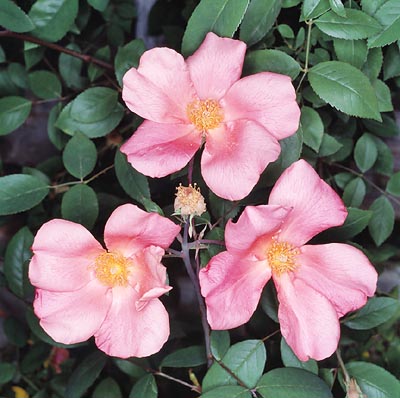
Rosa chinensis ‘Mutabilis’ © Giuseppe Mazza
Firstly, the flower of the future bride is prepared. The petals, which no longer need to seduce anyone, and the stamen, the masculine organs which might cause incest, are all taken off.
Then with a small brush, the feminine organ, the stigma, is powdered delicately with the pollen collected from the other plant, and we protect the entirety with a small envelope, in order to avoid any accidental crossings.
The granules of pollen germinate and produce some small filaments, the pollen tubes, which carry the sperm cells of the plant up to the ovules in the womb of the rose.
Hundreds of seeds come out from a single pollination. The chromosome combinations are numerous, and the children will each be different.
January and February are the best months for seeding. Every small plant has a numbered pot, and from the first days of the germination, the information concerning growth, resistance to bad weather and to diseases are all noted down with great care.
Just to give an idea of the enormous work, at Meilland, the largest breeder of roses in the world, they start with 100.000 germinated seeds for an initial selection of 6.000 small plants.
These are kept under observation for one year, and, in a second phase of selection, are reduced to 600.
The chosen ones will be then multiplied by vegetative means, and sent for 5-7 years of open-air observations to gardens scattered all over the world. This is because a rose which grows well under certain weather conditions will seldom adapt to all climates.
The few chosen ones will be finally patented throughout the world, for 15, 20, or 25 years according to national legislation, with a unique name, often unpronounceable, like MEIhourag, which for the modern roses begins almost always with the first three letters of the name of the breeder; in this case, MEI for Meilland.
Naturally, nobody would ever understand a rose called MEIhourag. For sale purposes, it is necessary to create a catchier name, depending on the language.
So in France, our MEIhourag is known as Arielle Dombasle, and in Italy as ‘Lea Massari’.
For each rose sold in nurseries, or offered as a cut flower, the breeder gets a royalty. Once the period of protection has passed, however, the variety falls into the public domain and anyone can reproduce it.
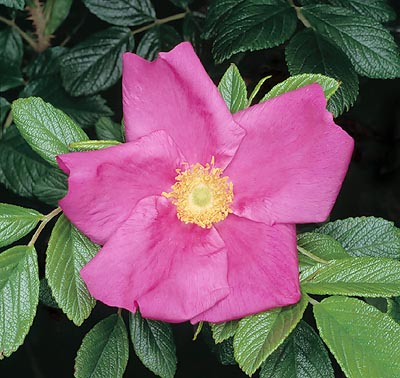
Rosa rugosa ‘Scabrosa’ © Giuseppe Mazza
The goose who lays the golden eggs can therefore become a dangerous competitor. The creator will have to convince the clients that the variety is by now obsolete, and that it had its faults after all.
To exploit its renaming, they will perhaps choose a similar sale name for the new queen, and will extol its extraordinary colour and fragrance with good publicity, not forgetting its awards.
But how does their formidable tool of seduction originate?
Whilst in most flowers the perfume springs out from the nectar, here it comes from the petals, and this only when they have reached a certain stage of ripening.
The perfume of the roses comes from a particular combination of terpene and alcohol, which varies according to the variety, the cultivation, and the climate; and the observer himself also plays his role.
Man, in fact, has a relatively bad perception of fragrance, something which deteriorates with age. For this reason some affirm that a rose has a certain perfume, and others assert that it has a completely different one.
It’s because of this that we can no longer recognise some of the perfumes of our infancy, and when they give awards for the fragrances of roses at the famous Bagatelle competition in Paris, the judges of the event are often children.
In order to understand each other, the creators of roses talk about five tones of fragrance:
The green note, which evokes the smell of freshly-mown grass.
The pink note, the rarest, which evokes the perfume of the ancient roses.
The citric note, which makes us think of verbena, lemon and citronella.
The note of fruit, with fragrances of peach, apricot, raspberry and strawberry.
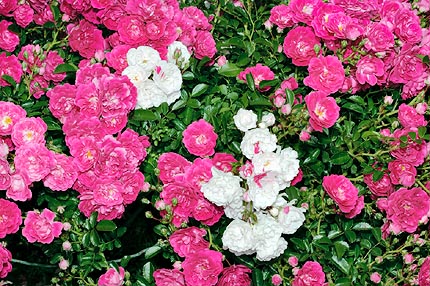
A sport of an ‘Excelsa’ rose © Giuseppe Mazza
The spicy note, which recalls vanilla, cinnamon, or nutmeg.
And given that the petals of the florists’ roses, which are cut when in bud, have not had the time to ripen, it is necessary to go to a garden in order to truly appreciate the fragrance of a rose.
So, in May, the Roseraie Princesse Grace de Monaco becomes a magical world of perfumes, a place for reliving distant times, and for observing, day after day, the development of more than 400 varieties of roses. A kaleidoscope of shapes, colours, and perfumes, each in perpetual change.
A rare event in nature, but nonetheless the case for some Proteaceae flowers which I came across in Australia and South Africa, is that some roses change their look as they age. The colour of the petals, in fact, comes from their complex structure and chemistry.
If we observe the petals under a microscope, they appear formed by three strata: the coloured cells of the upper side, a conical shape which gives a velvety look; the flat, coloured cells of the underside, which often create silvery shimmers; and, in the middle, an area without pigments, with miniscule air-pockets, so done to emphasize the colours with a fleshy iridescence.
There are many dyes, divided in two groups: the water-soluble ones, called anthocyans, which lodge in the vacuoles of the cells and change colour according to variation in pH; and the liposoluble ones, which dissolve only in fat substances, and remain outside the vacuoles in special organs called chromoplasts.
The final colour and the shades of the petals come from the combination of these components, which are at times at odds with one another.
So with time, as the pH of the petals changes, a white flower can become almost red. Many petals display an elegant contrast of colours at the apex, a small border more or less accentuated, simply because these parts were formed earlier and, in ripening, have lost their acidity first.
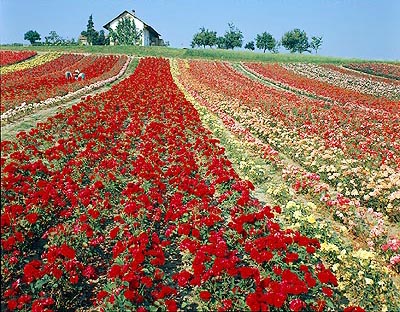
Field of roses © Giuseppe Mazza
To complicate things, the upper and lower sides of the petals can have different colourings, as is the case with many modern roses; one side can be pink, for example, and the other yellow. Colour mutations can affect the whole petal or only some areas, to the delight of the impressionist painters, by whom several bi-coloured roses have been honoured.
And what about the blue rose?
It does not exist in nature, as the rose does not have delphinidin, the pigment present in the Delphinium and the petunias, which is the basis of the blue colour in the flower world.
After centuries of hybridising between roses, we have been able, at best, to display some shades of mauve, but if we wish to have a truly blue rose, other bridges have to be crossed.
The Suntory Company in Japan has inserted, using genetic manipulation, the delphinidin of petunias and other species into the gene pool of a white rose; it, however, has begun to show lilac petals with reddish tendencies, because the vacuole containing this pigment is, by nature, too acidic.
This is similar to what happens, though the process is different, with the blue hydrangeas, which when the soil is unsuitable, produce mauve coloured flowers.
For those who are truly in love with blue roses, in Holland they have recently discovered a protein which controls the pH of the vacuoles of petals, and so maybe in the future they will get the basicity necessary to cultivate blue, genetically modified roses.
On the other hand, black roses exist already. For instance, the Black Baccara is so rich in purple-red pigments that it seems almost black.
It is a matter, for the most part, of cultivating varieties in greenhouses as cut flowers. This is because their dye, cyanide, darkens the petals under the sun at high temperatures. This initially gives them a pleasant look, but it becomes generally undesirable later on, with a burnt, parched appearance.
→ To appreciate the biodiversity of roses please click here.
→ BOOK ROSERAIE PRINCESSE GRACE DE MONACO
→ Article ROSES WITHOUT GRAFTING
